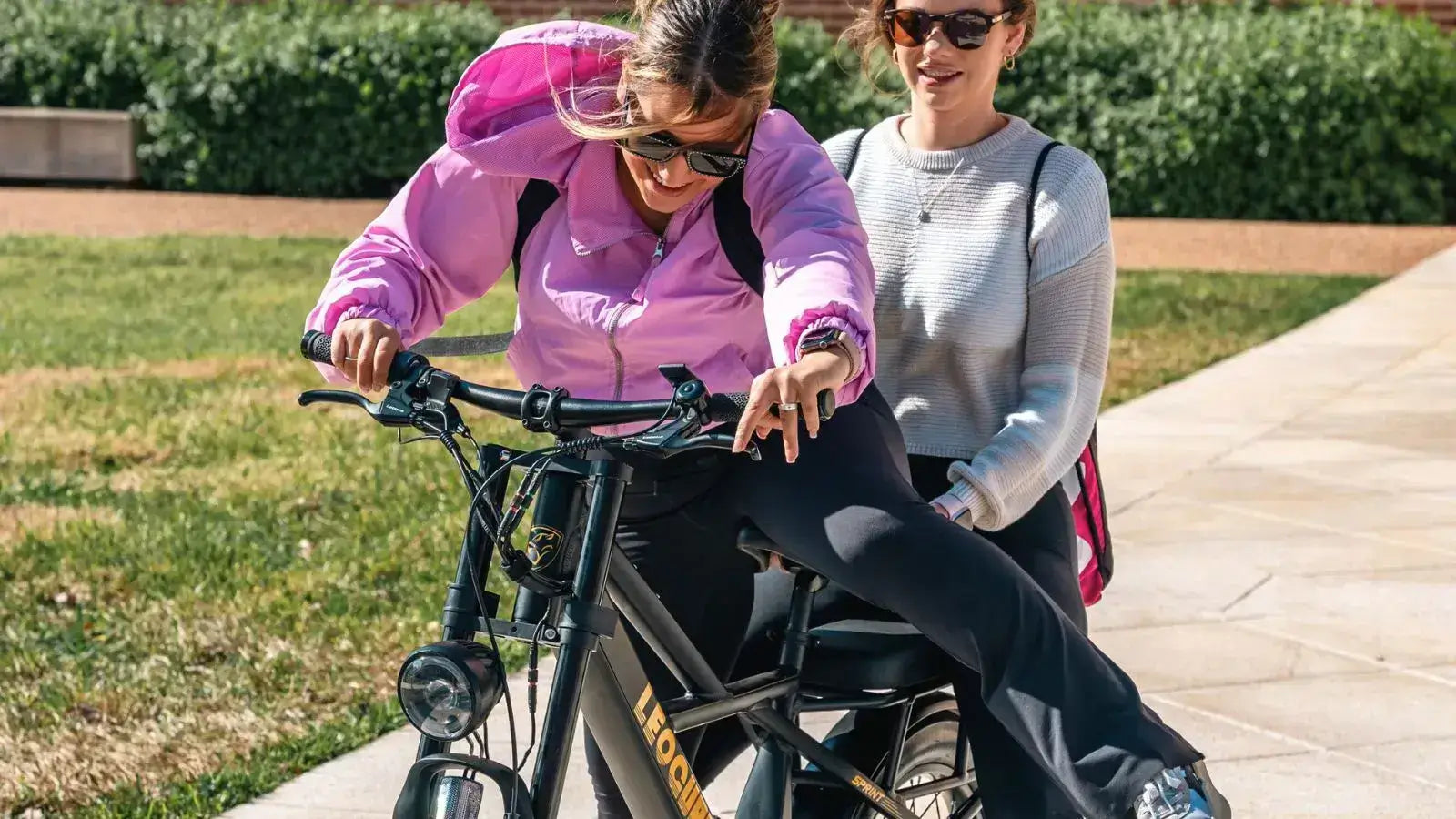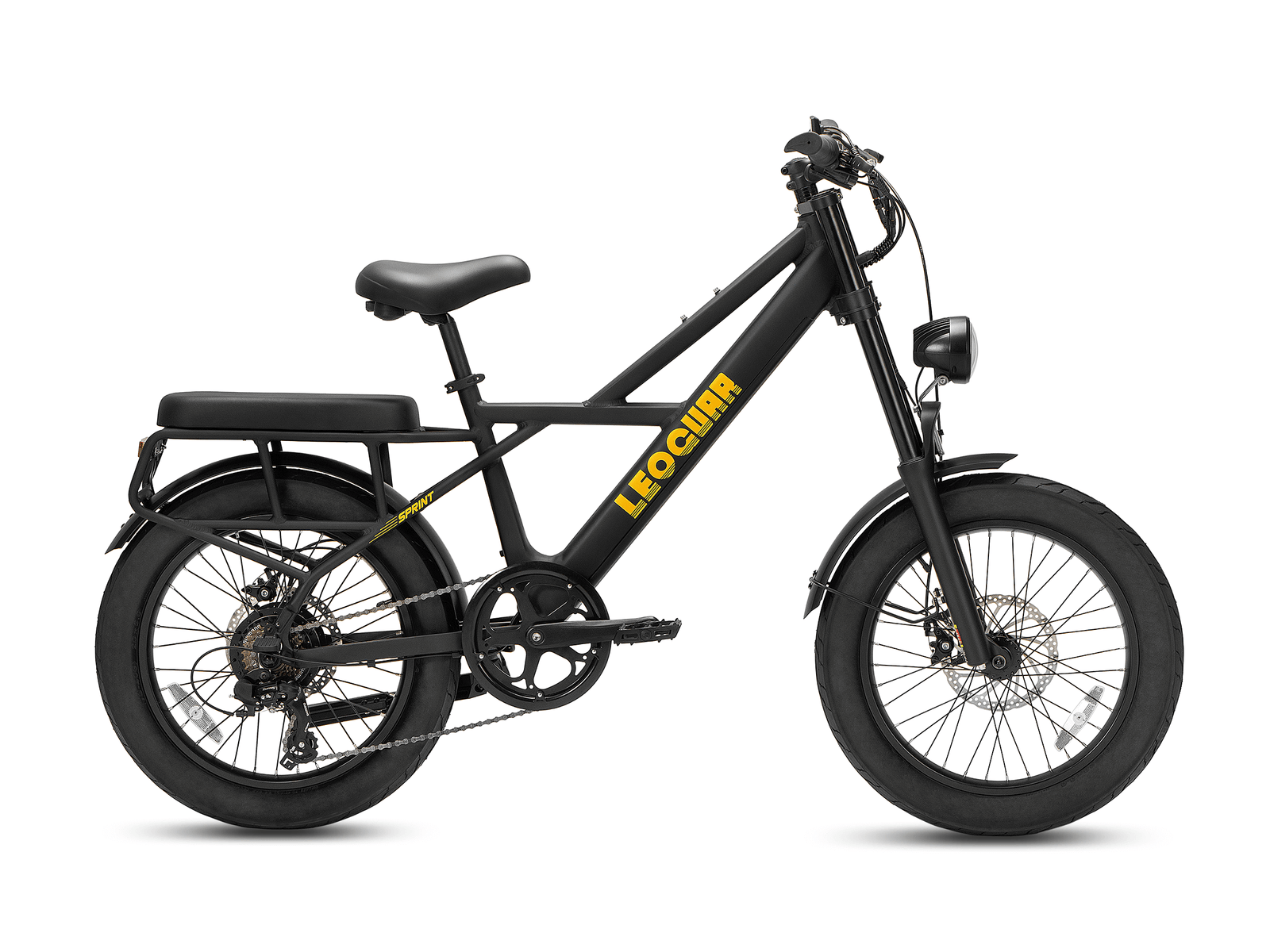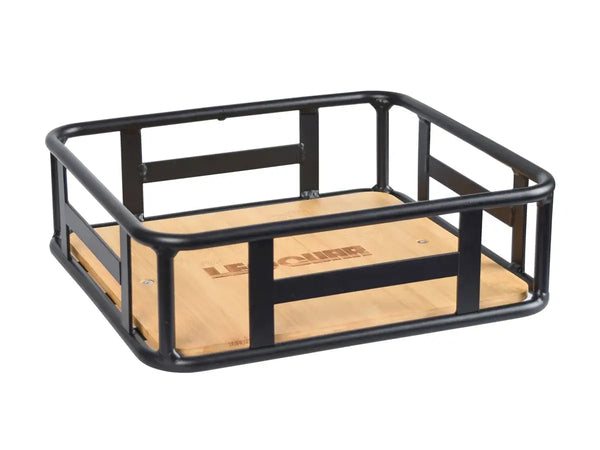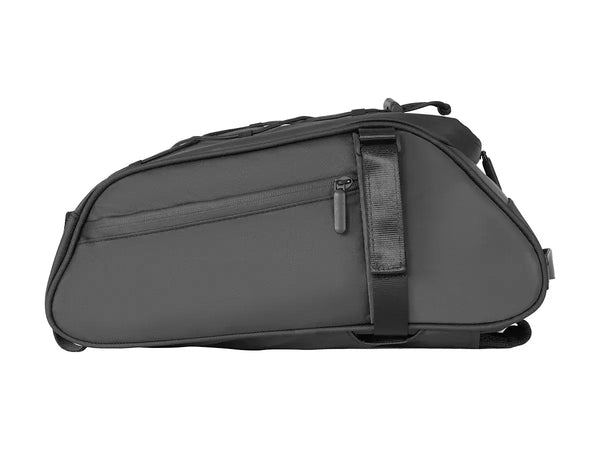
Utility Electric Bikes: Revolutionizing Cargo Transport
Stuck in traffic for a ten-minute trip to the store? Circling the block for parking just to grab a takeout order? The daily friction of using a car for short errands is a universal frustration. It's slow, expensive, and often stressful. This is where a new class of vehicle is making a big impact: the utility electric bike.
So, what is a utility electric bike? It's a powerful, do-it-all e-bike built to carry more than just the rider. It blends the quick, familiar feel of a commuter bike with the hauling strength of a dedicated cargo bike. These bikes are built to replace car trips, handling everything from the school run to the weekly grocery shop with ease. This guide will walk you through what defines these versatile machines, how they stack up against other e-bikes, their real-world uses, and exactly what to look for when choosing one for yourself.
Defining the Utility E-Bike
The term "utility" isn't just a marketing word; it means a specific design approach and a strong set of features that set these bikes apart. They are the multi-tools of the e-bike world, designed for riders who need their bike to do more than just get them from A to B.
Beyond a Standard E-Bike
At first glance, a utility e-bike might look like a stronger commuter bike. The key differences lie in the engineering. Frames are much stronger with thicker tubing and stronger welds to handle heavy loads safely. Unlike standard e-bikes where racks are often added later, utility models feature racks that are often built directly into the frame for maximum strength and stability. This strong construction results in a much higher weight capacity. While a typical e-bike might be rated for 250-275 lbs total, it's common for a utility electric bike to handle a total weight of 300 to 450 lbs.
Speed Meets Strength
The core design goal of a utility e-bike is to balance carrying capacity with how easy it is to ride. While a long-tail cargo bike can feel like riding a tandem bicycle, a utility model aims to keep a more traditional, quick ride feel. This is often done with smaller wheel sizes, typically 20-inch or 24-inch. These smaller wheels create a lower center of gravity, which greatly improves stability and handling when the bike is loaded with groceries or a child passenger. The result is a bike that feels confident and easy to handle in city traffic, not heavy.

Key Utility Parts
Several key parts work together to give these bikes their "do-it-all" ability. Understanding them helps clarify what makes this category so special.
- Built-in Racks: The rear rack is the heart of the bike's utility. It's almost always a heavy-duty, frame-mounted structure designed to hold significant weight (often 120 lbs or more) and accept a wide range of accessories.
- Powerful Motor: These bikes feature motors built for torque, not just speed. Whether it's a geared hub motor or a mid-drive system, the goal is to provide the power needed to get a heavy load moving from a standstill and up hills without struggle.
- Strong Frame: Look for oversized tubing and low step-through designs. The strength is for capacity, while the step-through shape makes it far easier and safer to mount and dismount when the rear rack is loaded.
- Accessory Mounts: A true utility e-bike is a platform. It will have numerous threaded mounting points on the frame and fork for adding front racks, baskets, guards, and other accessories to customize the bike for your specific needs.
Utility vs. Other E-Bikes
Choosing an e-bike can be confusing. The market is full of terms like "commuter," "cargo," and "utility." Thinking of them as different tools for different jobs makes the decision easier. A commuter bike is a scalpel, a cargo bike is a sledgehammer, and a utility e-bike is a versatile chef's knife. As experts at Consumer Reports note, many of these e-bike types can serve as practical transportation, but their strengths vary significantly.
A Detailed Comparison
To make the choice clearer, we've broken down the key differences between these three popular categories.
| Feature | Utility E-Bike | Long-Tail Cargo E-Bike | Commuter E-Bike |
|---|---|---|---|
| Primary Use Case | Daily errands, one child transport, car-lite lifestyle. | Full car replacement, transporting 2+ children, bulky items. | Solo commuting, fitness, point-to-point travel. |
| Hauling Capacity | Moderate: Groceries + 1 child (e.g., 300-450 lbs total). | High: 2+ children, large boxes (e.g., 400-500+ lbs total). | Low: Laptop bag, gym clothes (e.g., 250-275 lbs total). |
| Ride Feel & Speed | Quick and responsive, feels close to a regular bike. | Stable but less quick; longer wheelbase requires wider turns. | Fast, lightweight, and highly responsive. |
| Size & Storage | Moderately larger than a standard bike; fits in most garages. | Very long and bulky; requires dedicated garage or shed space. | Similar to a standard bicycle; easy to store in an apartment. |
| Typical Price Range | $$ - $$$ | $$$ - $$$$ | $ - $$$ |
Our Expert Analysis
Who should choose a utility e-bike?
This is the perfect choice for the urban parent doing the daily school drop-off, the individual living a car-lite lifestyle who needs to run weekly errands, or the small business owner making local deliveries. If you want to carry significant loads without giving up the fun and quick feel of a standard bike, this is your category.
Who should choose a long-tail cargo e-bike?
This is for those fully committed to replacing a second car. If your primary use case involves transporting two or more children, or you regularly need to haul large, bulky items, the extended frame and massive weight capacity of a long-tail cargo bike are essential.
Who should choose a commuter e-bike?
This bike is for the solo rider. If your primary needs are getting to work efficiently, exercising, or enjoying fast rides on bike paths, and you only need to carry a light backpack or a small bag, a dedicated commuter e-bike offers the best performance and lightest weight.
Real-World Utility Scenarios
Features and specs are important, but the true value of a utility electric bike is revealed in how it changes your daily routine. Based on our extensive experience, here are four scenarios where these bikes truly shine.
The School and Work Commute
The morning rush feels different on a utility e-bike. You start by easily securing a child seat to the sturdy rear rack. The low step-through frame means you don't have to swing your leg over a child's head to get on. With your child safely aboard, you set off. As you approach the first hill, the torque-sensing motor kicks in smoothly, neutralizing the extra weight and making the climb feel easy. You bypass the long line of cars at the school drop-off zone, pull right up to the gate, and then continue on your way to the office, feeling energized and having avoided the morning traffic jam entirely.
The Car-Free Grocery Run
Forget the stress of the supermarket parking lot. With large bags or baskets attached to the built-in rack, you have plenty of space for a full week's worth of groceries. After checkout, you load up the bags. The bike's low center of gravity and strong, wide kickstand keep it perfectly stable while you pack. As you ride home, the load feels secure and balanced, not swaying or unwieldy. You pedal past the gridlock of cars leaving the shopping center, feeling the satisfaction of a task completed with efficiency and ease.
The Small Business Workhorse
Imagine you're a local florist, baker, or photographer. A utility e-bike becomes your delivery vehicle. It's a low-cost, zero-emissions way to transport goods to customers in your community. The rear rack can be outfitted with a specialized insulated box or a custom crate. You can navigate narrow streets and find "parking" right at your customer's front door. It not only saves money on gas and insurance but also builds a powerful, eco-friendly brand image that connects with the community.
The Weekend Adventure Bike
A utility e-bike isn't just for work; it's for play. On a Saturday morning, you can load the rack with a picnic basket, a blanket, and a frisbee. Maybe you strap on a couple of folding chairs. You can easily ride to a local park, a beach, or a trailhead that would have been a hassle to drive to. The powerful motor opens up new possibilities, allowing you to explore further and tackle hills that might have been tough on a regular bike, turning a simple weekend outing into a memorable adventure.

A Buyer's Guide
When you're ready to purchase a utility electric bike, the technical specs can seem overwhelming. We've broken it down to the five most critical factors to consider to ensure you get a safe, capable, and reliable machine.
-
Motor Power & Type
For a utility e-bike, torque is more important than top speed. A motor's ability to provide low-end power is what gets a heavy load moving. Look for bikes with either a high-torque geared hub motor (often rated at 750W) or a mid-drive motor from a well-known brand like Bosch or Shimano. Mid-drives are often more efficient on hills but come at a higher price point. For most users, a quality 750W hub motor is more than enough. -
Battery Capacity & Range
Battery capacity is measured in watt-hours (Wh). A larger number means more range. For a utility bike that will be carrying loads, we recommend a battery of at least 600Wh. Be realistic about range claims. Manufacturers often test on flat ground with a light rider and low assistance. In the real world, expect a range of 25-50 miles, depending heavily on your load, the terrain, and how much motor assistance you use. -
Brakes are Non-Negotiable
This is a critical safety point. With the added weight of the bike and cargo, you need superior stopping power. Do not compromise here: insist on hydraulic disc brakes. Compared to mechanical disc or rim brakes, hydraulic systems offer significantly more stopping force with less hand effort and perform reliably in all weather conditions, especially the rain. -
Frame and Fork
A low step-through frame design is a game-changer for usability, allowing you to easily mount and dismount without having to swing a leg over a tall top tube, which is especially difficult with a child or cargo on the back. As for the front fork, some utility bikes have a suspension fork for added comfort, while others have a rigid fork for simplicity and strength. A suspension fork can smooth out bumps but adds weight and maintenance. -
System of Accessories
A utility e-bike is only as good as the things it can carry. Before you buy, investigate the accessory system. Does the brand offer its own line of child seats, passenger bars, large baskets, and bags designed specifically for the bike? Are the racks compatible with standard third-party systems like MIK or Racktime? A strong accessory lineup ensures the bike can grow and adapt to your changing needs.
Safety, Laws, and Ownership
Owning a utility e-bike is a rewarding experience, but it comes with responsibilities. Understanding the rules of the road and committing to basic maintenance will ensure your bike is a safe and reliable partner for years to come.
Know the Law
Electric bikes are generally categorized into three classes in the United States. Class 1 is pedal-assist only up to 20 mph. Class 2 has a throttle and assists up to 20 mph. Class 3 is pedal-assist only up to 28 mph. Most utility e-bikes fall into Class 2 or 3. It is crucial to check your local and state regulations, as they dictate where you can legally ride each class of e-bike—some bike paths may prohibit throttle-equipped (Class 2) or high-speed (Class 3) models.
Maintenance and Care
A utility e-bike is heavier and works harder than a standard bicycle. This means regular maintenance is not optional; it's essential for safety. At a minimum, you should regularly check your tire pressure, inspect your brake pads for wear, and keep your chain clean and lubricated. Because of the higher forces involved, we recommend a professional tune-up at a local bike shop at least once a year to ensure all components are in safe working order.
Frequently Asked Questions
Q: How much weight can a utility electric bike carry?
A: Most utility e-bikes can handle a total payload of 300 to 450 lbs, which includes the rider and cargo. This is significantly more than standard e-bikes that typically max out at 250-275 lbs total.
Q: What's the difference between a utility e-bike and a cargo e-bike?
A: Utility e-bikes offer moderate carrying capacity while maintaining a nimble, bike-like feel. Cargo e-bikes have higher capacity but are longer and less agile. Think of utility bikes as the middle ground between commuter and full cargo bikes.
Q: How far can I ride on a single charge with a loaded utility e-bike?
A: Range depends on battery size, load weight, terrain, and assistance level. With a 600Wh+ battery, expect 25-50 miles in real-world conditions. Heavier loads and hilly terrain will reduce range.
Q: Do I need a special license to ride a utility electric bike?
A: In most US states, no license is required for Class 1, 2, or 3 e-bikes. However, local laws vary, and some bike paths may restrict certain e-bike classes. Always check your local regulations before riding.
Q: Are utility e-bikes safe for carrying children?
A: Yes, when properly equipped with appropriate child seats and safety gear. Look for bikes with integrated racks, low step-through frames for easy mounting, and hydraulic disc brakes for reliable stopping power with the extra weight.











































Leave a comment